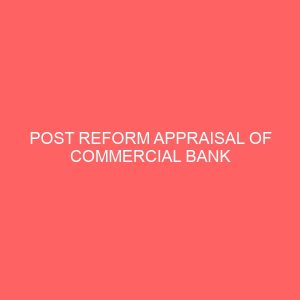Description
CHAPTER ONE
1.0 INTRODUCTION
1.1 BACKGROUND OF THE STUDY
This research is on Problems and challenges facing finance houses in the Nigerian economy ( A case study of mortgage bank owerri ). One of the universally accepted norms in the present day economic system is that functionality and survival of an economy is dependent on its financial system. Financial system workability depends on the viability of existing financial institutions. Financial institutions are establishment that handle monetary affairs and include banks (commercial, merchant, saving, mortgage and development) institution. Investors, insurance companies, finance and investment companies and discount houses.
Adekanya (1968:224) defines finance houses as privately owned investment companies which gives assistance to companies, which are unable to finance the purchase or leasing borrowing and hire purchase, but service provide by present day finance houses are numerous. Finance house are most often referred to as investment companies or houses.
Mortgage Banking is the mobilization of financial resources especially shares, savings and deposit from surplus economic units for financing housing investment needs of the deficit units in the economy. All banks participate in mortgage banking, but only mortgage finance institutions specialize in mortgage asset creation. The banks provide loans to mortgagor while the mortgage finance institutions give mortgages (i.e. legal change to property or asset) to the primary mortgage institution include:
- Saving and loans companies.
- Building societies.
- Mortgage societies.
- All of which specialize in financial intermediation for housing development.
Only mortgage banking institutions are allowed by law to have or to accept interest only in land as security. National Housing Co-operatives are housing finance institutions only but not mortgage finance institutions because they do not collect deposits and savings and funds are mainly distributed by members. And state housing corporations depend on state government budgetary allocations for direct housing development. Lastly local thrift institution are not mortgage bankers because there properties and rarely accepted as collateral.
Black and Daniel (1981:59) have the definition of investment companies as devices which allow budget surplus units to pool their fund and purchase investment in a diversified portfolio or financial claim by ways of an ownership. Investment company, Nwokolo (1991:79) said finance house constitute an aspect of non banking institutions.
The study requires significant intermediation effort because financial houses institution are expected to lend on long term even through their funds may be mobilized on a short term basis (BFLs) which are mainly in the banking of borrowing from and lending to the public. The definition on its own centers on borrowing and lending.
A clearly definition of finance houses given by Central Bank of Nigeria (CBN). In its guideline on the establishment of finance house issue on October 9, 1991, the guideline definition a finance houses as a person licensed to carry on finance company business.
1.2 STATEMENTS OF PROBLEM
So many individuals and organization are aware of the challenges such as;
- Lack of adequate legislation guiding their operation.
- They services are very expensive
- Many individuals and organization see them as jokers and may be fraudulent.
- The concentration of the finance companies in trade density urban area is also challenge.
1.3 OBJECTIVES OF THE STUDY
The objectives of this research is to explain what finance houses actually are, their service, challenges and problems in an economy so that the general public will go further into the economic development function performed by finance house.
1.4 RESEARCH QUESTION
- Do you think the public has derived any Benefit from finance house?
- Do your company participate in the Nigeria Stock Exchange?
- Do you accept funds of any kind?
- Does the existence of finance houses contributed immensely in the area of employment?
- Do you think that finance houses have significant effect on the country’s GDP?
- Do you think the establishment of finance houses has lead to increase in industrialization
- Were there any measures adopted to encourage Nigerians to invest in the Commercial Bank?
- Do you accept funds of any kinds?
- Do you think that existence of finance houses in Nigeria has impacted positively to the emergence of small and medium scale enterprises?
- STATEMENT OF HYPOTHESIS
It can simply defined as an assumption or statement made well in advance of observation (or actual collection of data) about what can be expected to occur concerning one or more populations under stated or given conditions. These assumptions or statements hen accepted to be true become theories and laws.
The following hypotheses are stated in their positive null form:
Hi: The establishment of finance houses in Nigeria has impacted positively to the emergence of small and medium scale enterprises, thereby lending to economic development of the country.
H2: The existence of finance houses has contributed immensely in the area of employment, thereby increase in industrialization.
1.6 SCOPE OF THE STUDY
The scope will cover the role of finance houses, the development of Nigeria economic. The study requires significant intermediation efforts because financial house institution are expected to lend on long term even though their funds may be mobilized on a short term basis.
1.7 SIGNIFICANCE OF THE STUDY
One of the keys to sustainable long-term economic development and democratic stability is the cultivation of an understanding of business and economy among policy matters business leavers and the public at large in this respect the media most play essential role in disseminating the critical introduction in a clear accurate and professional way.
Unfortunately journalistic in many developing countries must covers a wide range of the subject including business topic, yet in many case have little exposure to or training in market economic.
- This work is in partial fulfillment of the requirement for the award of Higher National Diploma (HND) in Banking and Finance.
- The work will be of immense help to future researcher who will make their investigation into the subject area.
1.8 LIMITATIONS OF THE STUDY
In a research work as this, a lot of problems are encountered. However, some of them are adjusting.
- TIME: Was a serious factor functioning their research work due to short duration at time, the submissive needed much pressure.
- FINANCE: A lot of money is needed collection in assembling.
- The researcher equally has problems and lecturers to attend to and it was not easy for me.
1.9 DEFINITIONS OF TERMS
- LIQUIDATION: This means winding up company or business organization. When a business liquidates, the business ceases to exist. It may be due to bankruptcy or a purpose for which it was founded has been completed as in the case of partnership.
- MATURITY DATE: In a financial asset is the date at which that asset is converted for a specified amount of money or physical assets e.g. the date at which an issuer of a bond promises to repay fully.
- COMMERCIAL PAPER: An unsecured debt instruments specified maturity date. It is priced at a discount from par and is redeemable at par on the maturity date.
- COLLATERIAL: A form of security, usually on and on which the lender has a claim.
- ILLIQUIDITY: A company that lacks potential ability inform of cash or asset that can be quickly coveted into cash, to meet the demands of creditors. It is a state of not being able to raise funds easily by selling assets.
- MORTGAGE BANKING: This is the mobilization of financed resources especially shares, savings, and deposit from surplus economic units for financing housing investment units of the deficit unit in the economy.
- DEFICIT: Excess of expenditure over an income of a business organization.
- INSOLVENT SITUATION: Insolvent situation of a business or a situation where the business has spent more than it realized.
- SHORT-TERM DIRECT LOAN INSTRUMENT: These are instruments used for or arising from the direct relationship between a borrower and a lender that intermediaries are not necessary engaged they include direct bank loans of not more than one year duration, non-bank loan (i.e. individuals and institutions). Banks loan can be with stipulated maturity and repayment condition. They are in the form of loans over draft credit lines discounting of bills.
- PRUDENTIAL GUIDELINE: Regulates how interest on loans and advances and other risk assets should be recognized and disclosed in the financial statement and how loan losses should be calculated.
- CASH RESERVE RATIO: This is the minimum level of cash to be deposited with the Central Bank of Nigeria expressed as a ratio of the banks total deposit liabilities.
- INTERNAL ENVIRONMENT: This can be regarded as all variables within the organization with effect strength or cause weakness to the organization.
- FINANCIAL RISK: Risk associated with introduction of debt capital in a capital structure, which is the risk that a company will not have adequate cash flow to meet financial obligations.
- CURRENT RATIO: Is the ratio of current assets to current liabilities. It assesses the extent of cover of the total liquid and illiquid assets over all short-term liabilities. This ratio is a measure potential ability of a firm to meet its short maturity obligation out of its gross working capital.
- LETTER OF CREDIT: A document issued by a bank or other financial institutions to a prospective borrower, to an agreed amount and for a definite or indefinite period.
- CREDIT POLICY: As summarized should set out the banks lending philosophy and objectives including the modalities for implementation monitoring, appraisal and review. It should be in writing to act a sign post to guide management and lending officers the primary purposes of a written credit policy is to provide a framework of standards and points of relevance within which individual lending personnel can operate independently and with relative uniformity and flexibility while making their individual decision within their respective delegated authority. The absence of this clean cut guideline may lead to characteristics in the application of credit polices by the credit officer or the concentration of all decision making in respect of approval of credits in the hands of one or two person at the top.
- CAPITAL ADEQUACY: Total amount of capital that must be maintained by financial institution in order to withstand potential risk.
- CORPORATE GOVERNANCE: Covers the system and structure by which companies are directed and managed in the best interest of owners and investors. It emphasizes the role and the responsibilities of the board of directors, exclusive and non executive members and shareholders night.
- EFFICIENCY: Seeking to ensure that the maximum output is obtained from the resources developed to a department (or programme), or conversely ensuring that the minimum level of resources is devoted to given level of output.
- INVESTMENT: An organizational or an individual share holding in another business. It involves putting money in a business enterprise in anticipation of return or income or profit over a given period.
- LEASE PURCHASE: A lease that includes a provision, whereby the lease holder may purchase the leased asset during the term of the lease usually at a favorable price.
- LIQUID ASSETS: These are resources of a firm which are either held in the form of cash within the accounting period or the operating cycle of the business.
- RETAINED EARNING: This is the amount of money held in a business after its owners have taken their share of the profits and transfers have been made to appropriate reserves.
- REVIEW OF FINANCIAL STATEMENT: A review made in accordance with generally accepted audit guidelines to given assurance that financial statements are in accordance with generally accepted accounting practice.
- INSOLVENCY: The inability of a company or an individual to meet maturing debts or obligations as they are due because liabilities for exceed the value of at the asset.
- LIQUIDITY RATIO: Liquidity ratio measures the ability of the firm to meet its current maturing obligation. A firm should ensure that it does not suffer from lack of liquidity, and also that it does not have excess liquidity. The failure of a company to meet its obligation, due to lack of satisfactory liquidity, will result in poor credit.








Reviews
There are no reviews yet.